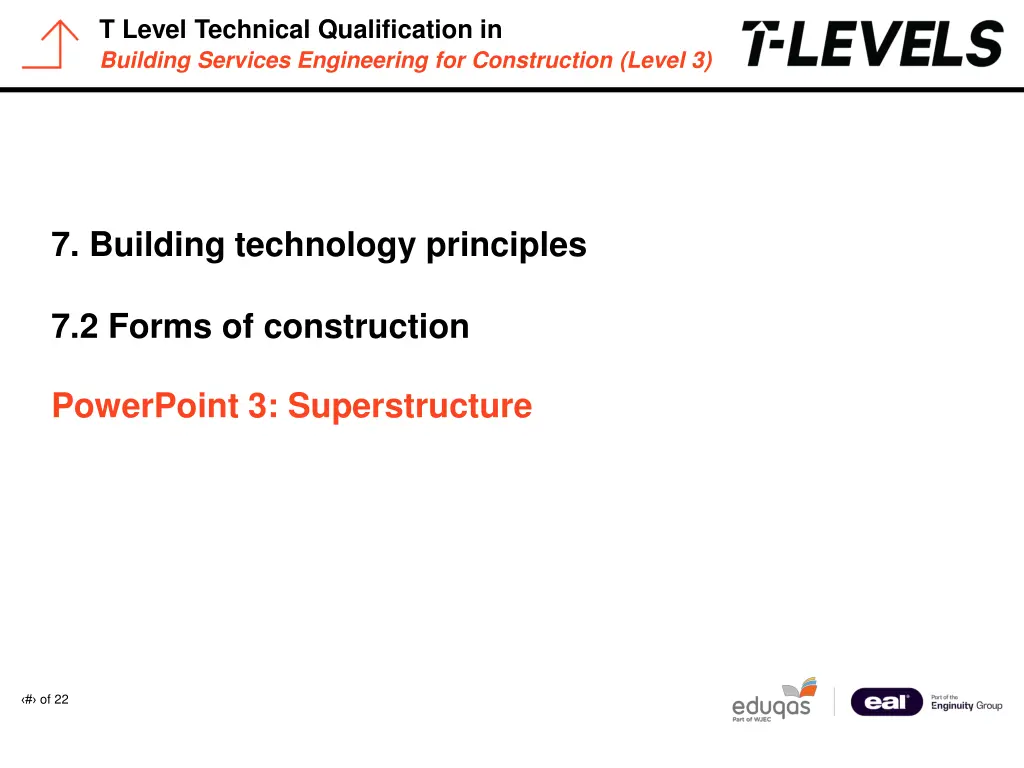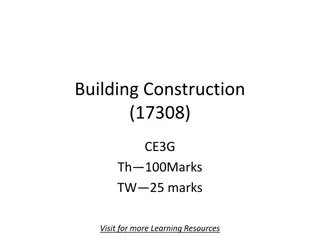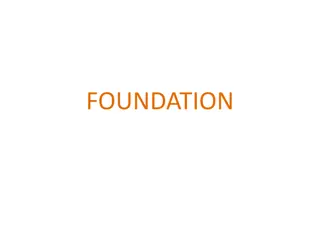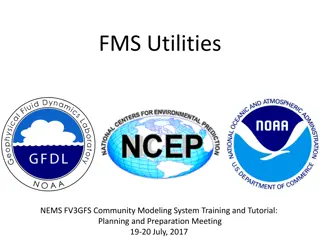
Building Services Engineering: Construction Superstructure Overview
Explore the fundamentals of building services engineering for construction, focusing on key aspects like superstructure, building envelope, structure, damp proofing, external walls, and cavity walls. Learn about the different components involved in constructing a building and the importance of each in providing shelter and protection for building occupants.
Download Presentation

Please find below an Image/Link to download the presentation.
The content on the website is provided AS IS for your information and personal use only. It may not be sold, licensed, or shared on other websites without obtaining consent from the author. If you encounter any issues during the download, it is possible that the publisher has removed the file from their server.
You are allowed to download the files provided on this website for personal or commercial use, subject to the condition that they are used lawfully. All files are the property of their respective owners.
The content on the website is provided AS IS for your information and personal use only. It may not be sold, licensed, or shared on other websites without obtaining consent from the author.
E N D
Presentation Transcript
T Level Technical Qualification in Building Services Engineering for Construction (Level 3) 7. Building technology principles 7.2 Forms of construction PowerPoint 3: Superstructure PowerPoint # of 22
T Level Technical Qualification in Building Services Engineering for Construction (Level 3) Building envelope The external envelope of a building consists of the materials and components that form its shell. These include walls, floors, roofs, windows and doors. Each may be load-bearing or non-load-bearing depending on the building design and structural form. # of 22
T Level Technical Qualification in Building Services Engineering for Construction (Level 3) Structure # of 22
T Level Technical Qualification in Building Services Engineering for Construction (Level 3) Superstructure A superstructure is the part of a building above the damp proof course (DPC). This includes the walls, floors and roof. The main function of the superstructure is to provide shelter from the elements and a safe, secure environment for the building s occupants. Elements of a superstructure: walls (internal or external) floors roofs windows doors. # of 22
T Level Technical Qualification in Building Services Engineering for Construction (Level 3) Damp proofing All buildings reach a stage where they need to be made watertight and protected from water ingress. Damp proofing is carried out to prevent moisture passing into the interior of a building. A DPC is installed in the walls and a damp proof membrane (DPM) under large surface areas such as the ground floor. # of 22
T Level Technical Qualification in Building Services Engineering for Construction (Level 3) External walls External walls come in a variety of different forms. For domestic purposes, cavity walling is generally the most popular form. A cavity wall consists of two parallel walls with a gap acting as a cavity. The cavity acts as a barrier to the elements (weather) with the outer leaf preventing wind and rain entering the inner leaf. The cavity is either partially or fully filled with insulation to prevent heat loss. # of 22
T Level Technical Qualification in Building Services Engineering for Construction (Level 3) Cavity walls Cavity walls are primarily built to provide a dry interior to a building. Constructing cavity walling has the following benefits. The cavity stops damp penetrating from the outer to the inner leaf. It improves the balance of temperature inside the building: cooler in summer, warmer in winter. # of 22
T Level Technical Qualification in Building Services Engineering for Construction (Level 3) Wall openings Openings are most commonly required in the external walls of a structure. Openings can be classified as horizontal or vertical. Horizontal openings are most commonly for windows to be installed and vertical for the installation of doors. The main purpose of an opening is to provide access and egress, to let natural light and air in and promote character in a building s design. Openings can present several problems including weakening the wall and structure above and rain getting around the edges of the opening. # of 22
T Level Technical Qualification in Building Services Engineering for Construction (Level 3) Lintels Lintels are used as a support above openings. A lintel is a structural support that spans the opening in a wall and is frequently used over both windows and doors. Lintels are most commonly used for load-bearing purposes but can also be decorative. Lintels are most commonly made from timber, steel or concrete. # of 22
T Level Technical Qualification in Building Services Engineering for Construction (Level 3) Weep holes Weep holes play an important role in masonry structures. The main purpose of weep holes is to provide drainage of moisture. They also allow ventilation, to prevent rot developing. Weep holes should be located as follows: on the outer leaf of a cavity wall above windows above doors at other areas where water may penetrate. # of 22
T Level Technical Qualification in Building Services Engineering for Construction (Level 3) Internal walls Partition walls are predominantly used to divide an internal space into rooms for privacy and security. Internal walls can be load-bearing or non- load-bearing. Load-bearing: help to distribute the combined loads of the building down to the foundations. They can also be used to provide lateral support and restraint to external walls. Non-load-bearing: designed to carry their own load together with any attached fixtures or fittings. They can be moved to change a building layout without affecting the structural integrity of the building. # of 22
T Level Technical Qualification in Building Services Engineering for Construction (Level 3) Types of internal wall Solid brick or block walls can be used internally as non-load-bearing walls. They provide good sound proofing and thermal performance. However, it is likely that more lightweight options will be used, such as timber or metal partitions. Timber or metal stud partitions are popular lightweight options for internal walls. Metal stud partitions are becoming increasingly used in modern construction. # of 22
T Level Technical Qualification in Building Services Engineering for Construction (Level 3) Internal partitions The main purpose of internal partitions is to divide space into usable areas and rooms. They provide privacy and security and may also provide fire protection and sound control. Key performances requirements Divide space. Provide flexibility for design layout. Structural support (If load-bearing). Fire performance. Sound reduction. # of 22
T Level Technical Qualification in Building Services Engineering for Construction (Level 3) Functions of a floor Provides a level surface to support the contents (live loads) of a building including people, furniture and equipment. Accommodates services including electrical, plumbing and water. Reduces sound transfer between adjacent floors. Provides a fireproof barrier between floors. # of 22
T Level Technical Qualification in Building Services Engineering for Construction (Level 3) Solid floors Solid floors bear directly onto the ground from which they gain their support. Solid ground floors consist of a compacted hardcore base with a DPM on top, covered with a bed of concrete. Solid floors need to be appropriately insulated in line with building regulation requirements. The insulation can either be placed under or on top of the concrete slab. A DPM prevents damp penetrating through the foundations into the ground floor. # of 22
T Level Technical Qualification in Building Services Engineering for Construction (Level 3) Block and beam floors Block and beam floors are becoming a popular choice in the industry as an alternative to a traditional suspended timber ground floor. This system is created using: beams: spanning between the supporting walls blocks: lightweight concrete blocks topped with grout, infilled between the beams. # of 22
T Level Technical Qualification in Building Services Engineering for Construction (Level 3) Suspended timber floors Suspended timber floors can be fitted at any level from the top floor to the ground floor. They are constructed from timbers known as joists, which are spaced parallel to each other, spanning the distance of the building. There are various types of joist that can be used to create a suspended timber floor. # of 22
T Level Technical Qualification in Building Services Engineering for Construction (Level 3) Roofs A roof must span between supporting walls and be able to support its own weight along with the wind loads to which it is exposed. The basic function of a roof is to offer protection from the elements. The roof also provides stability to the external walls. The roof is strapped to the walls using restraint straps, securing it in place so as to withstand the loads applied. Roofs need to be adequately insulated and ventilated. # of 22
T Level Technical Qualification in Building Services Engineering for Construction (Level 3) Flat roofs Flat roofs have a pitch of 10 degrees or less. A flat roof has a fall to allow rainwater to run off. This is to prevent water congregating, which will cause timbers to sag and leaks to appear. # of 22
T Level Technical Qualification in Building Services Engineering for Construction (Level 3) Pitched roofs Traditional cut roof Trussed roof Traditional roofs are constructed in situ using individual structural members set out and assembled by qualified site carpenters. Trusses are prefabricated offsite and delivered when they need to be installed by the site carpenters. This is a less time- consuming processes in comparison to a traditional cut roof and a more common method for new-build domestic developments. # of 22
T Level Technical Qualification in Building Services Engineering for Construction (Level 3) Windows The basic function of a window is to let natural light into a room. Widows also provide ventilation to prevent mould and remove stale air. They help prevent condensation. Windows provide a view of the outside world and are a prime aspect in terms of design considerations. # of 22
T Level Technical Qualification in Building Services Engineering for Construction (Level 3) Doors Doors can be categorised as internal or external. External doors provide protection from the elements and must be able to keep water out of the building and be weatherproof. UPVC doors are common for external purposes as they require little maintenance and don t degrade when exposed to the elements. Composite doors are another popular option created from a range of different materials. Timber external doors aremade from hardwood as they require durability when exposed to the elements. They come in a wide range of designs and can be very aesthetically pleasing. # of 22
T Level Technical Qualification in Building Services Engineering for Construction (Level 3) External works External works refers to any functional or aesthetic work carried out to the external environment of a building, inside the site boundary. Examples are paving, fencing, drainage, parking and supply of utilities. # of 22
T Level Technical Qualification in Building Services Engineering for Construction (Level 3) External works # of 22
T Level Technical Qualification in Building Services Engineering for Construction (Level 3) Paving Paving creates a paved surface. The term encompasses paving stones, bricks or asphalt. # of 22
T Level Technical Qualification in Building Services Engineering for Construction (Level 3) Fencing Provides privacy and secures the site boundary. Fences can also be used to cut down on or stop any unwanted access, pedestrian or vehicle. Fences can be low level such as timber posts and panels or high level such as security fences with concrete or metal posts and anti-climb paints. # of 22
T Level Technical Qualification in Building Services Engineering for Construction (Level 3) Drainage Drainage is the artificial removal of water, both surface and subsurface. Drainage allows excess water to be drained away and also provides a system to remove sewage. # of 22
T Level Technical Qualification in Building Services Engineering for Construction (Level 3) External services Prior to construction work commencing, information must be gathered to identify the existing services surrounding a development area. Ensuring utilities are supplied for the construction process and the finished development is vitally important. External services include: water mains supply electricity mains supply and distribution gas mains supply telecommunications and other communication system connections. # of 22
T Level Technical Qualification in Building Services Engineering for Construction (Level 3) Any questions? # of 22








